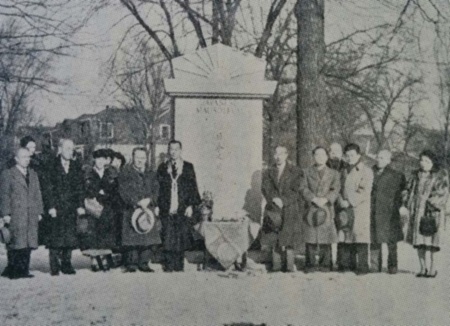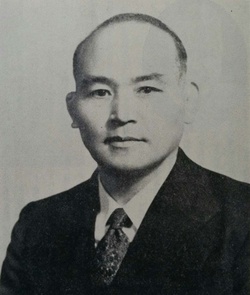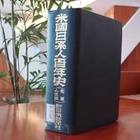Illinois is written as Illinois, but in the "Centennial History," it is written as "Illinois" in Chapter 18, perhaps because it was read as it is in the Roman alphabet. There is no set rule for writing English in katakana, and there seems to be no rule for replacing English with kanji, so even in the "Centennial History," there are some spellings that are not used today. The representative city of Illinois is Chicago, but it is sometimes written as Ichigogo.
Now, the chapter on Illinois in the "Centennial History" summarizes the footsteps of Japanese and Japanese-Americans in Chicago and its suburbs.
Pioneers from the Chicago World's Fair
First, about the "pioneers." The World's Fair was held in Chicago in 1893. There were Japanese people who went there hoping to make a name for themselves. The Centennial History says that the period from the Chicago World's Fair to the St. Louis World's Fair in 1904 should be called the pioneer era.
The first person introduced as a pioneer in this field is Nishikamenosuke.
"Until then, he had been running the Kinokuniya Inn in Soko and had been looking after Japanese immigrants on a large scale. He arrived at the Chicago World's Fair hoping to make some money, setting up a shop within the fairgrounds and selling bamboo crafts and miscellaneous Japanese goods, and was instrumental in introducing Japanese products to the country for the first time. Kushibiki Yumin, also known as the "King of Fairs," also brought a Japanese tea garden to the Chicago World's Fair and it was well received."
In addition, Sentaro Maeyama (from Wakayama Prefecture) opened an art souvenir shop in the downtown area and was a huge success. Yasuma Yamazaki (from Kochi Prefecture) opened the Jusen Restaurant at the St. Louis World's Fair and was a huge hit, and opened Western restaurants in Indianapolis and other places, and then went to Chicago and expanded his Western restaurants to various places.
Ushio Otake (from Yamagata Prefecture) opened a gift shop in 1916 and has been living in Chicago ever since. Kinji Shigeta was a photographer who came to the United States in 1920 and initially worked with movie actors in Hollywood, but was rejected by his white colleagues and moved to Chicago. He then joined a leading photo studio and rose to become the head photographer. "The Photographic Society of America chose him as its highest honorary member, one of only five in the world."
By 1920, the number of Japanese in Illinois had increased to 472, and in 1927, the "Japanese Association" was organized. However, compared to the size of the city, the number of Japanese was small, at only 400 to 500 people, half of whom were people on business trips from Japanese trading companies. In 1935, Yamazaki Yasuma and others organized the "Chicago Japanese Mutual Aid Association."
Population increase due to war and relocation
When the war began, small numbers of Japanese Americans began relocating from the West Coast to Chicago in 1942. In Chicago, the Chicago branch of the War Relocation Board cooperated to encourage Japanese people to relocate to Chicago. The number of Japanese who relocated in this way "was estimated to be 23,000 by January 1945."
"The Pacific Coast Evacuation Order was lifted on January 12, 1945, and with that came a huge wave of Japanese people returning to their old homes along the coast or to newly developed areas like Southern California, so that by 1950 the number of Japanese people in Chicago had fallen to around 20,000."
Overall, many Japanese and Japanese-Americans settled in Chicago as a result of relocation due to the war, and they went on to create the city's Japanese-American community. However, the Centennial History points out that problems arose during this large population shift.
One of these was the issue of illegitimate Japanese children.
"In 1947, there were more than 50 cases of illegitimate Japanese children that had to be dealt with by the Welfare Bureau." While he acknowledges that this was not limited to Japanese people, he sympathizes with them, saying that due to the tragic experiences of Japanese people being forced to move again and again, and the destruction of their families during the war, "this is something that often occurs when young women are forced to continue living alone in big cities."
Another problem was how to care for the elderly.
"Due to differences in language and customs, general nursing homes are not suitable for Japanese people, so it became necessary to establish a nursing home specifically for Japanese people."
After the war, the Chicago Support Group of the Japanese American Citizens League (JACL) was founded. In addition, the Chicago Relocation Committee was organized to introduce jobs and housing to Japanese people. Activities in the Japanese American community also became more active. A newspaper for Japanese people, the Chicago Shimpo, was published, and the "Homeland Refugee Relief" campaign began using this newspaper. In 1947, various Japanese American organizations participated in packing clothing for the Japanese Friendship Service Association to help Japanese refugees. Donations exceeded $13,000.
The Chicago Japanese Chamber of Commerce was established in 1948. In 1949, the Chicago Japanese Mutual Aid Association expanded its Japanese cemetery and relocated its ossuary.
In 1950, the Japanese population in Illinois was 11,646, but by the 1960 census, it had increased to 14,074. The reason for this is thought to be "the birth of third-generation Japanese and military brides, but the population had dropped sharply after wartime relocation, and now it appears that they have started to settle down."
King of the cleaning industry
As mentioned above, although there were pioneers in Chicago, many of them were people who relocated from the West Coast during and after the war. These people are introduced over 28 pages. Among them, the one who is given the most space is Torao Hidaka, the "King of the Japanese Washing and Dyeing Industry."
Hidaka was born in Takasaki-cho, Kitamorokata-gun, Miyazaki Prefecture, and moved to San Francisco in 1917 at the age of 19. He became an employee at a home cleaning company while attending elementary school, elementary school, and high school. During that time, he organized a Japanese youth group and established sumo, judo, and debate clubs. In sumo, he became known throughout the Japanese community in California as the ring name Hyuga-nada.
He married in 1924 and started a successful cleaning and laundry business in Demost, California. However, with the outbreak of war, the business closed and he was interned in a camp in Crystal City, Texas. There, too, he built a sumo ring and popularized sumo.
Two months before the end of the war, he moved to Chicago with his family and five children. He had only $400 in his pocket. After a while, he borrowed $1,500 from a friend and restarted his dry cleaning business. A year later, his sales had increased tenfold, and he was so successful that he obtained a loan from a bank that was sympathetic to his business acumen. He then expanded his business, built a factory, and expanded his store network to 25 locations.
In addition to his business, he organized Chicago's business community, served on the boards of directors of the Zen Buddhist Association and the Sumo Association, and made several donations and charitable contributions to Japan.
"Several years ago, upon hearing of the devastating flooding in his home country, he organized a sumo tournament to raise funds for the victims and sent the net profits of $550 through the Japanese Consulate. He also had a deep attachment to his hometown, and just after the war, when there was a shortage of supplies in his home country, he sent several baseball equipment and volleyballs to his alma mater, as well as several thousand pencils to encourage the cause."
(Note: I have used the original text as much as possible, but have made some edits. Titles have been omitted.)
*Next time we will introduce " Japanese people in the central northeastern states ."
© 2015 Ryusuke Kawai








